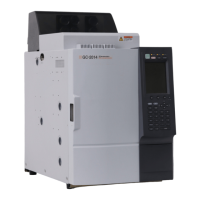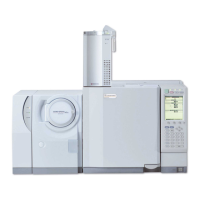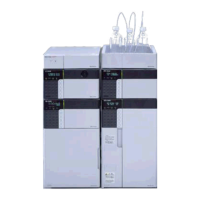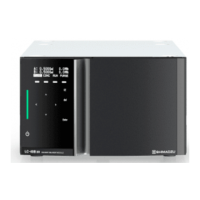Chapter 7 Troubleshooting
GC-2014 Service Manual
73
higher than the primary pressure. (As a rough guide, it should be at least
200 kPa, but this value depends on the column.)
Check whether or not the setting is within the range of settable
pressures/flowrates for AFCs. (A graph is given in the section on AFCs in
the GC-2014 instruction manual.)
(6) The pressure is higher than the setting (in split mode).
Check whether or not the setting is within the range of settable
pressures/flowrates for AFCs. (A graph is given in the section on AFCs in
the GC-2014 instruction manual.)
Check that a blind has not been erroneously attached to a split vent.
Check that [I time] = "1", [P term] = "100", and [I term] = "150".
If not, enter these values and press the pf4 key to write them in the ROM.
Check the [Offset] and [Gain] values.
The offset value is normally in the range 32,000 to 33,500 and the gain
value is normally in the range 3,000 to 6,000. If the offset value is well
outside this range, perform offset calibration. (The method is described in
the GC-2014 instruction manual.) If the gain value is well outside this range,
obtain the correct value from Shimadzu Corporation's Quality Assurance
Department. At this time, provide notification of the serial number and lot
number displayed on the side of the AFC.
Set the inlet pressure to 0 kPa and the total flowrate to 400 mL/min. At this
time, pressure is generated due to the flow-line resistance of the split line.
The specified value for this pressure is 50 kPa or less. (Normally 30 kPa.) If
it is greater than 50 kPa, identify the place where resistance exists using the
following procedure.
Remove the AFC's piping-line joint with the "s" mark band, one piece at a
time. If the pressure decreases when the joint on the lower stream of the
filter is removed, resistance exists in the split line inside the AFC. Next,
remove the joint on the upper stream of the filter. If the pressure decreases,
the filter is clogged. Prepare a new filter. Next, remove the joint on the upper
stream of the buffer. If the pressure decreases, the buffer is clogged. If the
pressure does not decrease, the cause originates in the INJ. Check the
glass insert and the split line inside the INJ.
If a glass insert for WBI is used, set the column insertion length (normally
34 mm) to approx. 15 mm.
(7) The purge flowrate does not agree with the setting.
Check that the column inlet pressure is sufficiently high.
A column inlet pressure of approx. 4 kPa is required for a purge flowrate of
1 mL/min. This means that, in analysis with an inlet pressure of 8 kPa, the
purge flowrate cannot be set higher than 2 mL/min.
Check that [I time] = "10", [P term] = "50", and [I term] = "100".
If not, enter these values and press the pf4 key to write them in the ROM.
Check the [Offset] and [Gain] values.
The offset value is normally in the range 32,000 to 33,500 and the gain
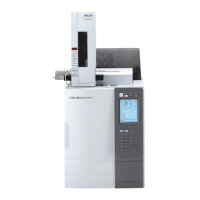
